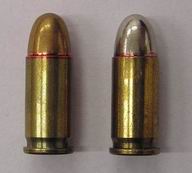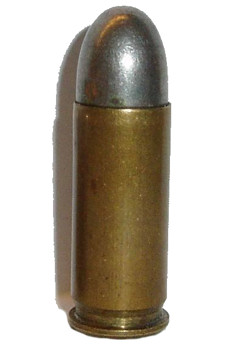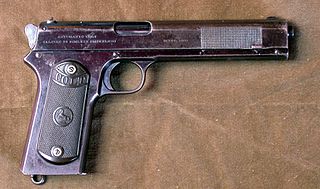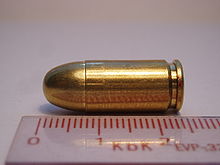
John Moses Browning was an American firearm designer who developed many varieties of military and civilian firearms, cartridges, and gun mechanisms – many of which are still in use around the world. He made his first firearm at age 13 in his father's gun shop and was awarded the first of his 128 firearm patents on October 7, 1879, at the age of 24. He is regarded as one of the most successful firearms designers of the 19th and 20th centuries and pioneered the development of modern repeating, semi-automatic, and automatic firearms.

The .45 ACP, also known as .45 Auto, .45 Automatic, or 11.43×23mm is a rimless straight-walled handgun cartridge designed by John Moses Browning in 1904, for use in his prototype Colt semi-automatic pistol. After successful military trials, it was adopted as the standard chambering for Colt's M1911 pistol. The round was developed due to a lack of stopping power experienced in the Moro Rebellion in places like Sulu. The issued ammunition, .38 Long Colt, had proved inadequate, motivating the search for a better cartridge. This experience and the Thompson–LaGarde Tests of 1904 led the Army and the Cavalry to decide that a minimum of .45 caliber was required in a new handgun cartridge.

The .380 ACP (9×17mm) is a rimless, straight-walled pistol cartridge developed by firearms designer John Moses Browning. The cartridge headspaces on the mouth of the case. It was introduced in 1908 by Colt, for use in its new Colt Model 1908 pocket hammerless semi-automatic, and has been a popular self-defense cartridge ever since, seeing wide use in numerous handguns. Other names for .380 ACP include .380 Auto, 9×17mm, 9mm Browning, 9mm Corto, 9mm Kurz, 9mm Short, and 9mm Browning Court. It should not be confused with .38 ACP. The .380 ACP does not strictly conform to cartridge naming conventions, named after the diameter of the bullet, as the actual bullet diameter of the .380 ACP is .355 inches.

.32 ACP is a centerfire pistol cartridge. It is a semi-rimmed, straight-walled cartridge developed by firearms designer John Browning, initially for use in the FN M1900 semi-automatic pistol. It was introduced in 1899 by Fabrique Nationale, and is also known as the 7.65×17mmSR Browning or 7.65 mm Browning Short.

The .25 ACP (6.35×16mmSR) is a semi-rimmed, straight-walled centerfire pistol cartridge introduced by John Browning in 1905 alongside the Fabrique Nationale M1905 pistol.

The .38 Super, also known as .38 Super +P, .38 Super Auto, .38 Super Automatic, .38 Super Automatic +P, or 9×23mmSR, is a pistol cartridge that fires a 0.356-inch-diameter (9.04 mm) bullet. It was introduced in the late 1920s as a higher pressure loading of the .38 ACP, also known as .38 Auto. The older .38 ACP cartridge propels a 130-grain (8.4 g) bullet at 1,050 ft/s (320.0 m/s), whereas the .38 Super pushes the same bullet at 1,280 ft/s (390.1 m/s). The .38 Super has gained distinction as the caliber of choice for many top practical shooting competitors; it remains one of the dominant calibers in IPSC competition.
A rim is an external flange that is machined, cast, molded, stamped, or pressed around the bottom of a firearms cartridge. Thus, rimmed cartridges are sometimes called "flanged" cartridges. Almost all cartridges feature an extractor or headspacing rim, in spite of the fact that some cartridges are known as "rimless cartridges". The rim may serve a number of purposes, including providing a lip for the extractor to engage, and sometimes serving to headspace the cartridge.

A moon clip is a ring-shaped or star-shaped piece of metal designed to hold multiple cartridges together as a unit, for simultaneous insertion and extraction from a revolver cylinder. Moon clips may either hold an entire cylinder's worth of cartridges together, half a cylinder, or just two neighboring cartridges. The two-cartridge moon clips can be used for those revolvers that have an odd number of loading chambers such as five or seven and also for those revolvers that allow a shooter to mix both rimless and rimmed types of cartridges in one loading of the same cylinder.

In American English, a pocket pistol is any small, pocket-sized semi-automatic pistol, and is suitable for concealed carry in a pocket or similar space.

The Colt Model 1903 Pocket Hammerless is a .32 ACP caliber, self-loading, semi-automatic pistol designed by John Browning and built by Colt Patent Firearms Manufacturing Company of Hartford, Connecticut. The Colt Model 1908 Pocket Hammerless is a variant introduced five years later in .380 ACP caliber. Despite the title "hammerless", the Model 1903 does have a hammer. The hammer is covered and hidden from view under the rear of the slide, this allows the pistol to be carried in and withdrawn from a pocket quickly and smoothly without snagging.

Star Bonifacio Echeverria, S.A. was a manufacturer of small arms in the Basque region of Spain from about 1905 until 1997.

The .38 ACP, also known as the .38 Auto or 9x23mmSR, is a semi-rimmed pistol cartridge that was introduced at the turn of the 20th century for the John Browning-designed Colt M1900. It was first used in Colt's Model 1897 prototype, which he did not produce. The metric designation for the round is 9×23mm SR (semi-rimmed), which is not to be confused with other 9×23mm cartridges.

The Colt Model 1900 is a short-recoil operated "self-loading", or semi-automatic .38 caliber handgun introduced by Colt's Manufacturing Company at the turn of the 20th century. It also marked the introduction of .38 ACP, the round for which it is chambered, and was the first handgun to utilize short-recoil operation.

The FN Model 1903, or Browning No.2 is a semi-automatic pistol designed by John Browning and manufactured by Belgian arms manufacturer Fabrique Nationale (FN). It was introduced in 1903 and fired the 9×20mmSR Browning Long cartridge. It should not be confused with the US-made Colt Model 1903 Pocket Hammerless, nor with the Colt Model 1903 Pocket Hammer. The FN Model 1903 is based on the same mechanical design as the Colt Model 1903 Pocket Hammerless, which Browning sold to both companies, but enlarged to handle the more powerful 9mm Browning Long cartridge. The M1903's reliability, accuracy, light weight, and quick reloading made it a popular service pistol for many police forces and militaries. The pistol was initially introduced by FN as the Browning Modèle de Guerre or Browning Grand Modèle.

The Model 1902 is a semi-automatic pistol developed by famous American firearms designer John Browning and produced by the Colt's Patent Firearms Manufacturing Company in the early 20th century. The Model 1902 was not a new design, but rather an incremental improvement upon the nearly identical M1900, and would transition from the 1900 into three distinct but related pistols with the same action and cartridge, the 1902 Sporting Model, the 1902 Military model, and the 1903 Pocket Hammer model. The 1902 Sporting model was so similar to the 1900 that it continued the serial number range, while the 1902 Military Model featured a different serial range as did the 1903 Pocket Hammer model. The 1902 Military Model featured a square and lengthened grip frame with an additional round in the magazine, while the 1903 Pocket Hammer featured a shortened barrel and slide but retained the Sporting model grip frame. The Colt M1905 .45 ACP pistol would be derived from the same lineage, also with a different serial number range.
The Colt Model 1903 Pocket Hammer was a short-recoil, semi-automatic pistol, designed by the American arms designer John Browning. It was a compact version of the Colt Model 1902 Sporting Model pistol derived from the original Colt M1900. The Colt M1902 Sporting Model and 1903 Pocket Hammer models differ significantly from the military-inspired Colt 1902 Military Model although they fire the same cartridge. Its design is in no way related to the Colt Model 1903 Pocket Hammerless or the FN Model 1903 pistol.

The 1931 Fabrique Nationale (FN) Baby Browning is a small blowback-operated semi-automatic pistol designed by Belgium-born Dieudonné Saive chambered in .25 ACP. The pistol features a six-round magazine capacity and is a striker-fired, single action, blow back mechanism. The manual thumb operated safety locks the slide in the closed position when engaged using side thumb pressure.

The 9mm Browning Long [9 x 20mm SR] is a military centerfire pistol cartridge developed in 1903 for the FN Model 1903 adopted by Belgium, France, Estonia, the Netherlands, and Sweden.
The .35 Smith & Wesson (S&W) is an obsolete centerfire pistol cartridge developed in 1912 for the newly designed Model 1913 self-loading pocket pistol.
















